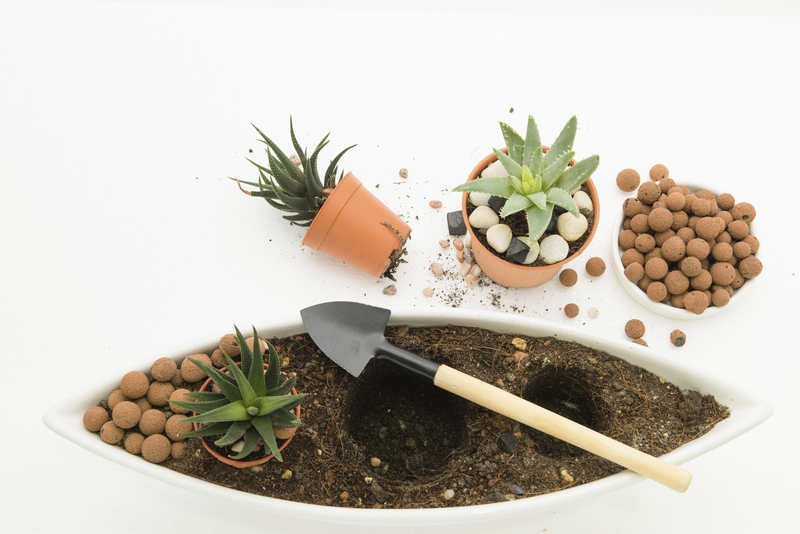Harnessing Wind Power: Tips for a Thriving Garden
Posted on 29/06/2025
Harnessing Wind Power: Tips for a Thriving Garden
Wind power isn't just for massive turbines or green energy companies--it can also transform your backyard into a flourishing, self-sustaining paradise. By strategically incorporating wind power into your gardening techniques, you can improve your plants' health, save on energy costs, and positively impact the environment. This guide provides practical, SEO optimized advice on harnessing wind energy to create a thriving garden.
Why Utilize Wind Power in Your Garden?
When most people consider wind power, they think of large-scale energy generation. However, harnessing wind energy for small-scale use in gardens offers unique advantages, such as:
- Reduces environmental impact by utilizing renewable resources.
- Assists in natural ventilation for plants, reducing pests and diseases.
- Supports renewable energy initiatives in your home and community.
- Enables off-grid solutions such as powering water pumps and garden lighting.
- Enhances plant resilience by stimulating stronger stems through gentle wind exposure.
Let's explore the various ways to use wind power for garden success and discuss tips that will help your garden truly thrive.

Understanding the Basics of Wind Power in the Garden
What is Wind Power?
Wind power is a form of renewable energy generated when moving air turns turbines or other mechanisms, which convert kinetic energy into usable electricity. In gardens, this can be accomplished with small-scale windmills, wind turbines, or even creatively designed kinetic sculptures that double as functional devices.
How Does Wind Affect Gardens?
Wind is a double-edged sword in gardening:
- Beneficial: Gentle breezes increase air circulation and help prevent fungal diseases, facilitate pollination, and encourage robust, sturdy plant growth.
- Harmful: Strong or persistent winds can damage delicate plants, dehydrate soil, and lead to increased evaporation.
Therefore, the goal is to harness wind power in ways that maximize its benefits while protecting against its detrimental effects.
Innovative Ways to Harness Wind Power in Your Garden
1. Install a Garden Wind Turbine
Small-scale home wind turbines are increasingly accessible and can be used to generate clean electricity for garden needs.
- Location: Place turbines where wind is steady and not blocked by structures or large trees.
- Size: Choose a size appropriate for your energy needs--many residential models suit lighting, pond pumps, or even greenhouses.
- Installation: Work with a professional or follow manufacturer instructions for safety and efficiency.
Tip: Combine solar panels with your wind turbine for energy generation, even on calm or overcast days!
2. Create Wind-Powered Water Features
Wind can be harnessed to operate water pumps, providing sustainable irrigation solutions or powering elegant water features that foster a calming outdoor environment.
- Install windmill-driven water pumps for ponds or raised beds.
- Use wind-powered aerators in fishponds to maintain water oxygenation.
- Utilize kinetic sculptures that move with the breeze to circulate water or assist in drip irrigation setups.
These eco-friendly approaches not only reduce reliance on electricity but also inject life and movement into your garden.
3. Enhance Pollination and Pest Prevention
Gentle garden breezes encourage pollination, especially for crops relying on wind or insect movement. Additionally, airflow can deter pests and reduce the occurrence of mildew or fungal outbreaks.
- Encourage natural ventilation by spacing plants appropriately and using trellises or lattices that channel wind flow.
- Place wind chimes or spinners strategically to disrupt flying insect paths.
- Use windbreaks (such as hedges or fences) to filter and direct airflow while offering shelter to sensitive crops.
With thoughtful design, harnessing wind power aids both pollinator activity and pest management.
4. Make Use of Windbreaks and Shelterbelts
While you want to harness breezes, protecting your garden from strong winds is just as critical. Constructing windbreaks--using shrubs, trees, or screens--can reduce wind speed by up to 50% and shield plants from the brunt of harsh gusts.
- Choose species naturally adapted to your region for hedgerows.
- Install lattice screens or natural fencing for a semi-permeable barrier.
- Design layered windbreaks with tall and short species to create an effective buffer.
Proper shelterbelt placement strategically channels wind, benefiting the entire garden's health!
Wind Power Solutions for Garden Sustainability
Powering Garden Lights and Devices
Using wind turbines, you can efficiently power:
- LED solar/wind hybrid garden lights
- Electric sprinklers or irrigation controllers
- Greenhouse fans and temperature control systems
- Automatic gate openers or security cameras
This not only lowers your electricity bill but also reduces your carbon footprint, making your garden a true model of sustainability.
Off-Grid Solutions for Remote Gardens
If your garden is located in a rural or off-grid area, small wind turbines or wind-powered devices are invaluable for maintaining plant health and providing necessary amenities. This includes:
- Pumping water from wells or rain barrels
- Supplying power to remote greenhouses or storage sheds
- Charging batteries for handheld gardening tools
Combining wind energy with solar power can provide round-the-clock, reliable electricity--regardless of weather.
Environmental and Economic Benefits
By investing in wind energy solutions for your garden, you unlock a host of benefits:
- Reduce greenhouse gas emissions associated with traditional electricity use.
- Pay less on utility bills in the long term.
- Boost property value through sustainable landscaping.
- Provide educational opportunities for children and visitors about renewable energy and ecology.
Planning and Installing Wind Power for Your Garden
Site Assessment: Finding the Sweet Spot
Effective wind harnessing begins with properly assessing your garden's wind profile:
- Observe wind direction and speed over several days and seasons.
- Select open areas free from obstructions like buildings or large trees.
- Test different locations with simple wind vane or anemometer tools.
Understanding your microclimate is the foundation for successful wind power implementation!
Choosing the Right Devices
There are a variety of wind-powered devices for gardens:
- Vertical Axis Turbines: Compact, quiet, and effective in turbulent or multi-directional wind environments.
- Horizontal Axis Turbines: Generally more efficient, but require consistent wind direction and higher mounting.
- Decorative Windmills: Can be paired with mechanical pumps or aerators for small-scale applications.
- Wind-Powered Kinetic Sculptures: Offer both beauty and functionality, generating minor amounts of energy or assisting with ventilation.
Consider your energy goals and garden aesthetics before making a choice.
Installation and Safety Tips
- Secure all wind devices with sturdy mounts or concrete bases to prevent tipping.
- Install away from children's play areas and walkways for safety.
- Follow all local codes and zoning regulations before installing turbines or large wind devices.
- Schedule regular maintenance to remove debris and check for wear and tear.
Proper installation is critical to achieving both safety and optimal energy yield.
Maximizing the Benefits of Wind Energy in the Garden
Combine with Other Eco-Friendly Solutions
- Solar Panels: A hybrid wind-solar setup ensures power generation in varying weather conditions.
- Rainwater Harvesting: Wind-powered pumps can distribute collected rainwater throughout the garden, maximizing resource efficiency.
- Composting Systems: Use wind-driven aeration to speed up compost decomposition and reduce odors.
These combinations create a holistic, sustainable backyard ecosystem.
Monitor and Adjust to Changing Conditions
- Regularly inspect wind devices for damage, rust, or blockage.
- Adjust windbreaks and plant positions seasonally as wind patterns shift.
- Use mulch and ground cover to prevent soil erosion and dehydration caused by wind exposure.
Flexible, ongoing management ensures your garden remains both productive and energy efficient.
Educate and Involve Your Community
Sharing your experiences with wind power in gardening can inspire others to adopt renewable energy strategies. Host workshops, plant tours, or school demonstrations to showcase:
- Wind turbine or windmill installations
- Home-built kinetic energy sculptures
- Eco-friendly irrigation systems
Community involvement amplifies the positive impact of your efforts and spreads environmental awareness!

Frequently Asked Questions: Wind Power in the Garden
Can I install a wind turbine in a small garden?
Absolutely! Small wind turbines and decorative windmills are designed for limited spaces. Just ensure you have enough clearance and choose a quiet model to limit noise disturbance.
Will wind power affect all plants positively?
Most sturdy plants benefit from moderate wind exposure, which strengthens stems and improves pollination. However, delicate or tropical species may need extra protection--address this with selectively placed windbreaks.
How much energy can I realistically generate for my garden?
Typical garden turbines or windmills generate enough power for lighting, irrigation pumps, or small appliances. Actual output depends on wind speed, turbine size, and placement, but they are ideal supplements to reduce dependency on the grid.
Are there downsides to harnessing wind power at home?
Potential challenges include installation costs, noise, and aesthetic preferences. However, modern devices address many of these concerns, blending efficiency, quiet operation, and appealing design.
Conclusion: Cultivate Success by Harnessing the Wind
Harnessing wind power for your garden is a forward-thinking approach to sustainability, plant health, and energy savings. By thoughtfully selecting and installing wind-powered devices, optimizing garden layouts, and combining with other eco-friendly solutions, you'll nurture a flourishing oasis for plants, wildlife, and your family. Not only will you boost productivity and reduce environmental impacts, but you'll also take a proactive role in a greener future--one breeze at a time.
Ready to start? Assess your garden's wind potential and try one of the actionable tips above to transform your outdoor space with the natural energy of the wind!





